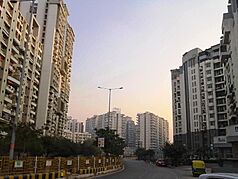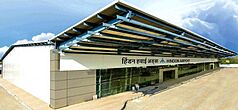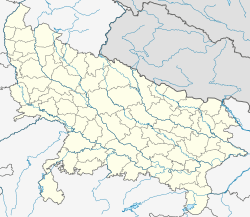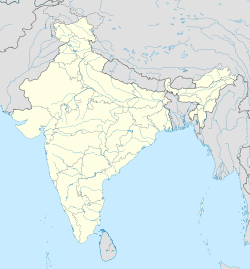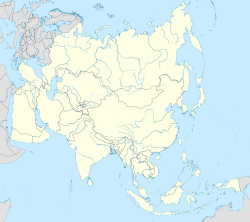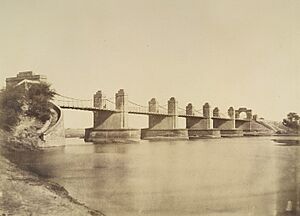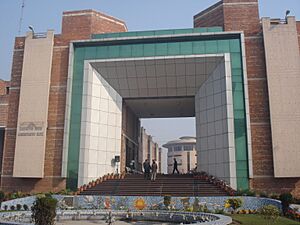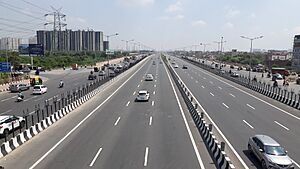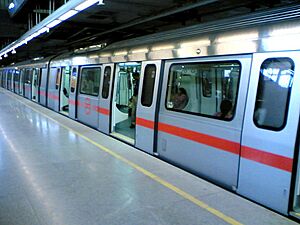Ghaziabad facts for kids
Quick facts for kids
Ghaziabad
|
|
|---|---|
|
Clockwise from Top:
Indirapuram Skyline, Shipra Mall, Clock House, Hindon Airport, Kaushambi Skyline and Institute of Management Technology |
|
| Nickname(s):
Gateway of Uttar Pradesh
|
|
| Country | |
| State | |
| Division | Meerut |
| District | Ghaziabad |
| Government | |
| • Type | Municipal Corporation |
| • Body | Ghaziabad Municipal Corporation |
| Area | |
| • Total | 210 km2 (80 sq mi) |
| Population | |
| • Total | 1,729,000 |
| • Density | 8,230/km2 (21,300/sq mi) |
| Demonym(s) | Ghaziabadi |
| Languages | |
| • Official | Hindi |
| Time zone | UTC+5:30 (IST) |
| PIN |
201 XXX
|
| Telephone code | 91-120 |
| Vehicle registration | UP-14 |
Ghaziabad is a big city in the Indian state of Uttar Pradesh. It is part of the Delhi NCR. Ghaziabad is the main city of the Ghaziabad district. It is also the largest city in Western Uttar Pradesh.
The city has a population of about 1.7 million people. The Ghaziabad Municipal Corporation manages the city. It is split into 5 zones and has 100 wards. Ghaziabad is well connected by roads and railways. It is a major train hub for North India.
People sometimes call it the "Gateway of Uttar Pradesh." This is because it is very close to Delhi. It is on the main road that leads into Uttar Pradesh. Ghaziabad is one of the fastest-growing cities in the world. This is due to a lot of new buildings and development. The city is in the Upper Gangetic Plains. The Hindon River divides it into two parts: Trans-Hindon (west) and Cis-Hindon (east).
Contents
History of Ghaziabad
The city of Ghaziabad was started in 1740 A.D. by Ghazi-ud-Din II. He was a top minister, called a wazir, for the Mughal emperor Muhammad Shah. He named the city "Ghaziuddinnagar" after himself.
The name "Ghaziuddinnagar" became shorter, turning into "Ghaziabad." This happened when railways started in 1864. During the Mughal period, the banks of the Hindon River in Ghaziabad were a popular picnic spot for the Mughal royal family.
A group called the Scientific Society was set up here. This was an important step in the education movement started by Syed Ahmad Khan. In 1864, the Scinde, Punjab & Delhi Railway opened. It connected Delhi and Lahore through Ghaziabad, going up to Ambala.
By 1870, another railway line was finished. This line connected Amritsar, Saharanpur, and Ghaziabad. This meant Delhi was linked to Multan through Ghaziabad. Ghaziabad then became a key railway junction. It connected the East Indian Railway and the Sind, Punjab and Delhi Railway.
During most of the British Raj, Ghaziabad was one of three main legal areas. These were under the Meerut Civil Judgeship. Ghaziabad was also part of the Indian independence movement. It played a role in the Indian Rebellion of 1857.
Ghaziabad used to be part of the Meerut district. It became its own district on November 14, 1976. This change was made by the chief minister at that time, N.D. Tiwari.
People and Languages
Population in Ghaziabad
In 2011, the Ghaziabad urban area had about 2.3 million people. There were more males than females. The city had a very high literacy rate of almost 99%. This means most people could read and write.
Ghaziabad is the second largest industrial city in Uttar Pradesh. Only Kanpur is bigger.
| Religions in Ghaziabad (2011) | ||||
|---|---|---|---|---|
| Religion | Percent | |||
| Hinduism | 82.50% | |||
| Islam | 14.18% | |||
| Sikhism | 0.96% | |||
| Christianity | 0.78% | |||
| Jainism | 0.71% | |||
| Other or not stated | 0.87% | |||
| Distribution of religions | ||||
The Ghaziabad Municipal Corporation had about 1.6 million people. For every 1000 males, there were 885 females. The literacy rate was 84.78%. About 12.67% of the people were under 6 years old.
Hindi is the most common language spoken in Ghaziabad. Other languages like Urdu and Punjabi are also spoken by some people. Because Ghaziabad is near Delhi, you might hear many other languages too.
Economy and Industry
Ghaziabad got its first modern factory in 1940. This was even though it had railways since 1865. After India became independent in 1947, many more factories opened. In just four years, 22 new factories started. This growth happened because many people and businesses moved from the newly formed Pakistan.
One big company, John Oakey and Mohan Ltd., moved here in 1947. They make sandpaper and other abrasive products. The Mohan Meakin breweries also started in 1949. Ghaziabad became famous for making oil engines.
In 1967, the city's boundaries grew to the Delhi-UP border. In the early 1970s, many steel factories opened. This made steel one of the city's main industries. The Electronics industry also grew. Companies like Bharat Electronics Limited and Central Electronics Limited were set up.
Many large Indian companies helped develop industries here. These include Mohans, Tatas, Modis, and Shri Rams. Some foreign companies also invested, like Danfoss India Ltd.
Getting Around Ghaziabad
Road Travel
There are plans to make National Highway 24 (NH-24) much wider. It will go from four lanes to fourteen lanes. This change will be on the part between the Ghaziabad-Delhi border and Dasna. Many new homes and shops are being built along this highway.
Train Travel
The Delhi Metro has two lines that serve Ghaziabad. These are the Blue Line and the Red Line. They connect Ghaziabad with Delhi. The Red Line has 8 stations in the city. Its last station, Shaheed Sthal, is in Ghaziabad.
The Blue Line has 2 stations in Ghaziabad. These are Kaushambi and Vaishali. They serve areas like Kaushambi, Vasundhara, and Indirapuram.
The main train station is Ghaziabad Junction. It is a very important station. It has been running since 1864. It is a key stop on the Howrah–Delhi main line. About 50,000 passengers use this station every day.
The Delhi–Meerut RRTS is a fast train system. It connects Delhi, Ghaziabad, and Meerut. Part of it is already open to the public.
Air Travel
Hindon Airport is an airport that serves Ghaziabad. It started working in 2019. It is the second commercial airport in the Delhi–NCR region. The first is Indira Gandhi International Airport. The Prime Minister of India, Narendra Modi, opened Hindon Airport.
The Indira Gandhi International Airport is the closest international airport. Hindon Airport currently has flights to Pithoragarh, Uttarakhand, and Hubli, Karnataka.
Ghaziabad was ranked 18th best "National Clean Air City" in India in 2024. This was for cities with over 1 million people.
Education in Ghaziabad
Ghaziabad has become a big center for education. Many colleges and institutes are in the city. Some of the main ones are:
- Christ University Delhi NCR Campus
- IMS Engineering College
- Institute of Management Technology (IMT)
- Institute of Technology and Science, Mohan Nagar, Ghaziabad
- Raj Kumar Goel Institute of Technology
- Santosh Medical College
Notable People from Ghaziabad
Arts, Entertainment, and Television
- Lara Dutta, who was Miss Universe in 2000 and is a Bollywood actress.
Business Leaders
- Nikesh Arora, a businessman who used to be a top leader at SoftBank Corp.
- Kapil Mohan, a businessman.
Sports Stars
- Aaditya Tyagi, a cricketer.
- Rajkumar Baisla, a wrestler who won the Dhayanchand Award in 2011.
- Donald Crowhurst, a sailor.
- Manoj Prabhakar, a cricketer.
- Suresh Raina, a cricketer.
See also
 In Spanish: Ghaziabad para niños
In Spanish: Ghaziabad para niños


